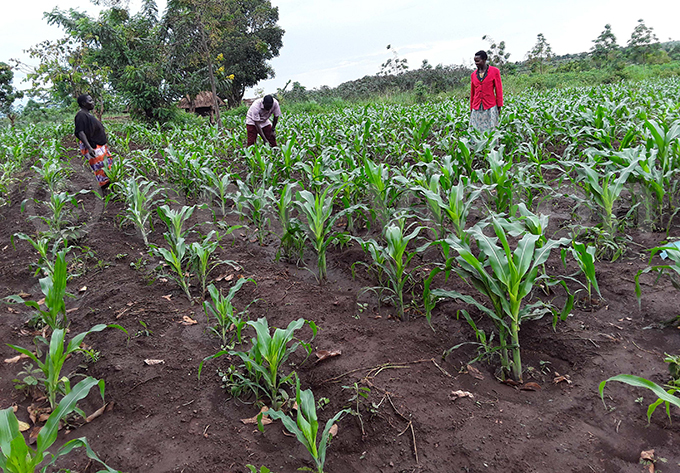Farmers get tips on maize planting techniques
Planting using this technology increases crop resilience to effects of prolonged drought and erratic rainfall patterns
Maize is one of the crops capable of combating food insecurity but at the same time, an income generating activity in most parts of the country.
It is consumed widely in the country, the reason why it is grown by almost every household especially in the Albertine region.
However, like any other crop, maize is vulnerable to various challenges, ranging from pests and diseases to adverse weather conditions like drought as this deprives the soil of moisture that is needed for proper plant growth.
Most farmers also cannot afford irrigation systems to water their crops until the rains surface.
To help such farmers, researchers at Bulindi Zonal Agricultural Research Development Institute based in Hoima district, have embarked on the promotion of planting maize in permanent planting basins (PPBs) technology.
According to Jude Abitegeka, the farm manager at Bulindi ZARDI, the PPB technology involves digging up of holes called basins in which maize is planted for more than one season.
Planting using this technology increases crop resilience to effects of prolonged drought and erratic rainfall patterns, hence increasing yields by between by 50-100%.
To make the basins, the field should be slashed before it can be dug. The PPBs should be dug at a length of 35cm, width 15cm and depth of 15-20cm.
When planting maize in basins, farmers should adhere to the recommended inter-row spacing of 75cm, because the basins should be spaced at 70 cm from the center of each basin using a seeding rate of three seeds per basin.
 A garden with maize in planting basins. Photo by Prossy Nandudu
A garden with maize in planting basins. Photo by Prossy Nandudu
During planting, Diamonium Phosphate (DAP) fertiliser is applied. Planting should be followed by spraying the garden with herbicide to kill emerging weeds. At knee height, top dress with urea using the same rate of application as DAP.
Abitegeka adds that urea as a fertiliser is important because it provides nitrogen which is required mainly for vegetative growth in plants.
Benefits of using PPBs technology
He adds that the basins help in controlling soil erosion as runoff water is trapped and retained for use by plants for a longer period of time.
It also minimises production costs because it allows precise application of fertilisers or manure, labour costs are also minimised because there is no ploughing, only minor weeding is involved, and the same basins are used to plant other crops in the subsequent seasons.
In this practice, soil disturbance is minimised as other crops are planted in the same basins in a rotational manner in subsequent seasons according to Wilber Wambi a plant breeder at the institute.
He adds that the technology results into increased plant population per acre (17,777) compared to the conventional spacing (4,960). This translates into high yields that range between 3,233 and 5,836 kgs per acre, depending on the variety and the sub-ecological zone.